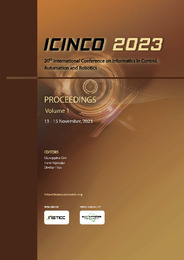Please use this identifier to cite or link to this item:
https://hdl.handle.net/11000/31574Full metadata record
| DC Field | Value | Language |
|---|---|---|
| dc.contributor.author | Santo López, Antonio | - |
| dc.contributor.author | Gil, Arturo | - |
| dc.contributor.author | Valiente, David | - |
| dc.contributor.author | Ballesta, Mónica | - |
| dc.contributor.author | Peidro, Adrian | - |
| dc.contributor.other | Departamentos de la UMH::Ingeniería de Sistemas y Automática | es_ES |
| dc.date.accessioned | 2024-02-28T11:29:54Z | - |
| dc.date.available | 2024-02-28T11:29:54Z | - |
| dc.date.created | 2023-11 | - |
| dc.identifier.citation | Proceedings of the 20th International Conference on Informatics in Control, Automation and Robotics - (Volume 1) | es_ES |
| dc.identifier.isbn | 978-989-758-670-5 | - |
| dc.identifier.issn | 2184-2809 | - |
| dc.identifier.uri | https://hdl.handle.net/11000/31574 | - |
| dc.description.abstract | The correct assessment of the environment in terms of traversability is strictly necessary during the navigation task in autonomous mobile robots. In particular, navigating along unknown, natural and unstructured environments requires techniques to select which areas can be traversed by the robot. In order to increase the autonomy of the system’s decisions, this paper proposes a method for the evaluation of 3D point clouds obtained by a LiDAR sensor in order to obtain the transitable areas, both in road and natural environments. Specifically, a trained sparse encoder-decoder configuration with rotation invariant features is proposed to replicate the input data by associating to each point the learned traversability features. Experimental results show the robustness and effectiveness of the proposed method in outdoor environments, improving the results of other approaches. | es_ES |
| dc.format | application/pdf | es_ES |
| dc.format.extent | 15 | es_ES |
| dc.language.iso | eng | es_ES |
| dc.publisher | INSTICC - Institute for Systems and Technologies of Information, Control and Communication | es_ES |
| dc.relation.ispartof | Proceedings of the 20th International Conference on Informatics in Control, Automation and Robotics Volume 1 | es_ES |
| dc.rights | info:eu-repo/semantics/openAccess | es_ES |
| dc.rights.uri | http://creativecommons.org/licenses/by-nc-nd/4.0/ | * |
| dc.subject | Autonomous Mobile Robots | es_ES |
| dc.subject | Artificial Intelligence | es_ES |
| dc.subject | Neural Networks | es_ES |
| dc.subject | Sparse Convolution | es_ES |
| dc.subject | Point Clouds | es_ES |
| dc.subject.other | CDU::6 - Ciencias aplicadas::62 - Ingeniería. Tecnología | es_ES |
| dc.title | Computing the Traversability of the Environment by Means of Sparse Convolutional 3D Neural Networks | es_ES |
| dc.type | info:eu-repo/semantics/article | es_ES |
| dc.relation.publisherversion | https://doi.org/10.5220/0000168300003543 | es_ES |

View/Open:
3-2023_ICINCO_Traversability_A_Santo (1).pdf
3,25 MB
Adobe PDF
Share:
.png)
